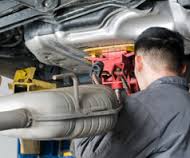The brakes on your vehicle should always be in top working order. Educate yourself on the symptoms of trouble so you know when to have a professional take a look.
Malfunctioning brakes are one of the most dangerous deficiencies on a vehicle. If you’re not able to stop your car when you need to, it could lead to fatal accidents for yourself and others. While your car will usually do a good job of notifying you when the brakes need to be checked, knowing what signs to look for will help you stay on top of the problem before it gets too dangerous.
The simplest sign is your dashboard warning lights. Depending on the source of the problem and the model of the car, the light may just be the word brake, or else an exclamation point inside of a circle. The “ABS” light stands for anti-lock brake system, so seeing that could be another warning sign. Check your manual if you aren’t sure what your dashboard alerts look like.
There are also distinct sounds that could indicate some trouble with the brakes. If you hear a high-pitched squeal, that is your brake pad alert telling you that your brake pads are wearing down. A grinding noise means that your pads are already worn through, and they’re rubbing against the rotor. Either of these sounds requires immediate attention.
Another place you might notice something off is the brake pedal itself. If your pedal goes all the way to the floor when you engage it, it could be a brake fluid leak, or a problem with the hydraulic system. Conversely, if the brake pedal is harder to depress than usual, this could be an issue with your boosters. Your brake pedal also may vibrate, which is likely due to warped rotors.
If your car is pulling to one side or the other when the brake is applied, you could have a caliper that is stuck, or possibly a hydraulic issue. This pulling occurs because one of the brakes is engaged longer than the other, causing it to drift to one side. For this pulling to be a brake issue, it will only occur when you’re using your brakes. If the vehicle is pulling more consistently, even when the brakes aren’t applied, this is probably an alignment or suspension problem instead.
Your brakes give you many signs that they need help, so don’t ignore these symptoms. It’s recommended that regardless of any obvious problems, you should have your brake system checked every 10,000 miles. This number could be more or less depending on your driving habits. City driving, or driving in traffic regularly, requires you to use your brakes more often, meaning inspections should be more frequent.
Visit this website for more information on brake repair in San Diego.




